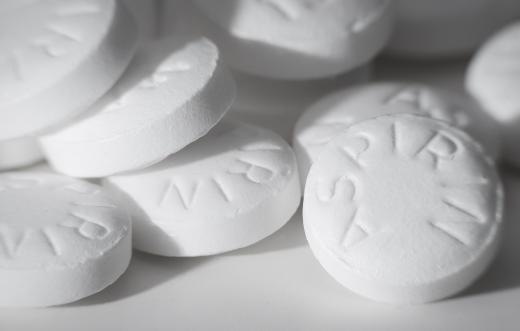What is Prostaglandin Synthesis?
Prostaglandin synthesis is the manufacture of lipid compounds within the cells of some animals, including humans. These substances are chemical messengers that mediate biological processes, such as inflammation, and are important in the normal function of many different tissues. Certain enzymes initiate prostaglandin synthesis by catalyzing a series of metabolic reactions that convert a fatty acid into the final biologically active product. Drugs such as aspirin prevent the synthesis of prostaglandin and thus reduce pain and inflammation.
In many animal tissues, prostaglandins function as cellular signaling molecules that have functions ranging from sending the brain a signal about body temperature to sensitizing neurons to pain. These lipid compounds come in three major subtypes, and together comprise the eicosanoids, a biologically active fatty acid group. Prostaglandin synthesis occurs within cells whenever one of the compounds is needed, but are not stored in specialized compartments as biologically important molecules usually are. With many different effects on neurons, muscles, and epithelium, prostaglandin is being synthesized almost constantly within the body.

When enzymes known as cyclooxygenases (COXs) are released, prostaglandin synthesis begins through the oxidation of fatty acids, particularly arachidonic acid. The fatty acids themselves come from the same sources as the lipids that compose the cell membrane. Oxidation changes their basic structure into whichever type of prostaglandin is needed at the time. COX 1 is the enzyme responsible for maintaining the body's normal levels of prostaglandins, while COX 2 mediates synthesis when tissues are injured or infected. Synthesis occurs in almost every cell type, with the exception of white blood cells and those lacking nuclei.

Any time tissue injury occurs, various immune cells migrate to the site. This process of cellular response triggers COX-2 release, resulting in prostaglandin synthesis at the damaged part of the body. The prostaglandins lead to an inflammatory response, triggering fever and limiting infection and tissue loss. Another variety regulates some of the blood's clotting mechanisms, controlling where a clot may or may not form. The prostaglandin known as PGE-2 effects changes in the uterus, including contractions, and commonly is used medically to induce labor or abortion.
Various chemicals can inhibit prostaglandin synthesis — aspirin is a well-known example. Both COX-1 and COX-2 are inhibited by aspirin, which prevents the oxygenation of arachidonic acid that is necessary for synthesis. By preventing the enzyme activity, aspirin stops the inflammatory pathway and reduces fever along with pain sensitivity, since both decrease without the effects of prostaglandin. Along with compounds such as ibuprofen, aspirin is one of the non-steroidal anti-inflammatory drugs (NSAIDs). In contrast with steroids such as cortisone, the NSAIDs prevent prostaglandin production rather than treat its effects.
AS FEATURED ON:
AS FEATURED ON:












Discussion Comments
It has been suggested that the death toll of the 1918 flu pandemic may have been larger due to aspirin. The suggestion does have some merit.
There is a possibility that wide usage of aspirin may have caused overdose deaths. It is suggested that it was overprescribed in the panic of the flu's wake.
Critics of this hypothesis say that it would be wrong to jump to such a conclusion. It was very disturbing seeing a disease with such a high mortality rate. Even though there may be some hints of aspirin involvement, there just isn't enough evidence.
Until 1956 aspirin was a widely used miracle pill. In 1956 the invention of paracetamol or acetaminophen really put a damper on the aspirin market.
Aspirin has recently had a second wind. In the past 20 years, due to its use in preventing and assisting with treatment of the heart, it has become widely used again. Extensive studies found aspirin is an anticlotting agent. Aspirin has made its way into many emergency rooms now.
Post your comments